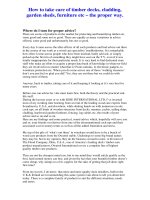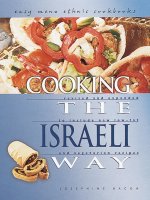- Trang chủ >>
- Đại cương >>
- Kinh tế vĩ mô
cooking the austrian way
Bạn đang xem bản rút gọn của tài liệu. Xem và tải ngay bản đầy đủ của tài liệu tại đây (5.98 MB, 74 trang )
easy menu ethnic cookbooks
Cooking
r e vised and expanded
the
the
to include new low-fat
AUSTRIAN
and vegetarian recipes
way
way
H E L G A H U G H E S
the
way
Cooking
AUSTRIAN
Disclaimer:
Some images in the original version of this book are not
available for inclusion in the eBook.
To my cooking teacher, Frau Anna Merighi,
whose favorite saying was “Liebe geht durch
den Magen,” (“Love goes through the
stomach”)
Copyright © 2004 by Lerner Publications Company
All rights reserved. International copyright secured. No part
of this book may be reproduced, stored in a retrieval system,
or transmitted in any form or by any means—electronic,
mechanical, photocopying, recording, or otherwise—with-
out the prior written permission of Lerner Publications
Company, except for the inclusion of brief quotations in an
acknowledged review.
Lerner Publications Company,
A division of Lerner Publishing Group
241 First Avenue North
Minneapolis, MN 55401 U.S.A.
Website address: www.lernerbooks.com
Library of Congress Cataloging-in-Publication Data
Hughes, Helga.
Cooking the Austrian way / by Helga Hughes.—Rev. and expanded.
p. cm. — (Easy menu ethnic cookbooks)
Summary: An introduction to the cooking of Austria including such
traditional recipes as Wiener schnitzel, potato noodles, and Sacher cake.
Also includes information on the geography, customs, and people of this
European country.
eISBN: 0–8225–1698–5
1. Cookery, Austrian—Juvenile literature. 2. Austria—Social life and
customs—Juvenile literature. [1. Cookery, Austrian. 2. Austria—Social
life and customs.] I. Title. II. Series.
TX721 .H82 2004
641.59436—dc21 2002152146
Manufactured in the United States of America
1 2 3 4 5 6 – JR – 09 08 07 06 05 04
easy menu ethnic cookbooks
Helga Hughes
a
•
the
way
revised and expanded
to include new low-fat
and vegetarian recipes
Lerner Publications Company Minneapolis
Cooking
AUSTRIAN
Contents
INTRODUCTION, 7
The Land and Its People, 8
Regional Cooking, 9
Holidays and Festivals, 10
BEFORE YOU BEGIN, 17
The Careful Cook, 18
Cooking Utensils, 19
Cooking Terms, 19
Special Ingredients, 20
Healthy and Low-Fat Cooking Tips, 22
Metric Conversions Chart, 23
AN AUSTRIAN TABLE, 25
An Austrian Menu, 26
BREAKFAST, 29
Jelly Rolls, 30
Cinnamon and Almond Snails, 32
DINNER, 35
Egg Custard Soup, 36
Paprika Chicken, 37
Breaded Veal, 38
Trout Vienna Style, 41
Potato Noodles, 42
SUPPER, 57
Cooked Potato Salad, 43
Broccoli Salad with Bacon, 45
Cucumber Salad, 46
Mixed Green Salad, 46
DESSERTS & PASTRIES, 49
Linzer Cake, 50
Salzburger Sweet Soufflé, 53
Sacher Cake, 54
Pork Stew, 58
Colorful Variety Platter, 60
Tomato Baskets, 60
Salami Cones, 60
Herb-Stuffed Eggs, 61
Smoked Salmon-Stuffed Eggs, 61
HOLIDAY & FESTIVAL
FOOD, 63
Bacon Bread, 64
Holiday Fruit Bread, 66
Fried Carp, 67
Red Cabbage with Apples, 68
INDEX, 70
A
ustrian cuisine typifies the saying that “variety is the spice of life.”
Throughout Austrian history, different groups of people settled in the
country, and each group brought its own customs and cuisine. As the
various groups mixed, they helped shape Austrian culture. In ancient
times, Celts and Romans settled in Austria, and the country became
part of the Roman Empire. Later, various Germanic groups and
Magyars (Hungarians) settled there. Austria had various rulers until
the tenth century A.D., when the Babenberg family gained control.
The Babenbergs ruled for two hundred years, and Vienna became an
important trading center during their reign.
Crusaders (Christian soldiers who fought to win Palestine from the
Muslims during the eleventh, twelfth, and thirteenth centuries)
stopped in Vienna on their way home from the Middle East. They
brought sugarcane, muscat, and spices such as pepper, ginger, cinna-
mon, cloves, and nutmeg, which Austrians incorporated into their
foods.
In 1278 the powerful Habsburg family took control of Austria and
acquired surrounding regions. In 1683, under Habsburg rule, Austria
Austrian cooking is influenced by many world cuisines. A hearty Austrian dinner might
include paprika chicken (recipe on page 37), potato noodles (recipe on page 42), and
egg custard soup (recipe on page 36).
7
CZECH
REPUBLIC
D
a
n
u
b
e
R
i
v
e
r
SLOVAKIA
Linz
UPPER
VIENNA
Vienna
AUSTRIA
SWITZERLAND
LOWER AUSTRIA
GERMANY
Eisenstadt
Salzburg
Neusiedler Lake
Bregenz
AUSTRIA
BURGENLAND
VORARLBERG
HUNGARY
TIROL
Innsbruck
SALZBURG
STYRIA
Graz
TIROL
LIECHTENSTEIN
CARINTHIA
Klagenfurt
ITALY
SLOVENIA
conquered Hungary and became the center of a huge and powerful
empire. Austrian cooking was influenced yet again—by foods from
Romania and the former republics of Czechoslovakia and Yugoslavia.
During the 1700s and 1800s, famous composers such as Mozart
and Haydn lived in Austria. The Habsburgs ruled this cultural center,
the Austrian Empire, for six hundred years, until its downfall during
World War I (1914–1918). The empire consisted of more than fifty
million people and included twelve nationalities. Many of Austria’s
famous recipes developed as a result of this long and complex history.
The Land and Its People
Austria is only about the size of Maine, but it has a population of
more than 7.5 million people—approximately six times the popu-
lation of Maine. Austria is bordered by Switzerland and
8
Liechtenstein to the west; Germany, the Czech Republic, and
Slovakia to the north; Hungary to the east; and Slovenia and Italy to
the south.
The Alps stretch across the western, southern, and central parts of
Austria and form the dominant feature of the country. In many
places, beautiful, green valleys lie between the mountains. Austria
also has many lovely lakes and dense forests. Austria’s scenic beauty
attracts millions of tourists each year.
Vienna, the capital of Austria and its largest city, lies on the
Danube River. Other large Austrian cities include Salzburg,
Innsbruck, Linz, and Graz.
Like the United States, the heritage of Austria has been enriched
by the mixture of many different cultures. In Austria most city
dwellers live in apartment buildings. Town and village residents
usually live in single-family homes. However, housing styles vary
from region to region. German, the official language of Austria, is
spoken by 98 percent of the people.
Austrians’ lifestyles reflect their rich history. They are proud
that Austria continues to be a leading cultural center of Europe. Most
Austrians enjoy art, music, outdoor sports, and good food.
Austrians also place great importance on the preparation of their
food.
Regional Cooking
Wiener schnitzel is probably Austria’s most popular dish. In the
movie The Sound of Music, set in Austria, Julie Andrews even sings that
schnitzel and noodles are one of her favorite things. Yet each of
Austria’s nine provinces (Burgenland, Carinthia, Lower Austria,
Salzburg, Styria, Tirol, Upper Austria, the city of Vienna, and
Vorarlberg) claims fame for a culinary specialty.
Both Lower Austria, the chief wine-producing area of the country,
and Vienna are renowned for their coffeehouses and delicious pastries.
9
People in Styria, a southeastern province, prepare hearty meals,
such as Fridatten, a soup made from sliced, rolled pancakes in a
bouillon broth, or Styrisches Schweineres, a one-pot stew.
The southernmost province is Carinthia, where Austria’s highest
peak, the 12,641-foot (3,853-meter) Gross Glockner is located.
Many inns still use old family recipes to cook fish and game, which
are abundant in this province. Nothing is wasted—not even the
bones, which are used for broth. Carinthians are also proud of the
many kinds of noodles they offer—savory noodles filled with ham,
bacon, mushrooms, or cottage cheese, as well as sweet noodles filled
with dried fruit and covered with melted butter and sugar.
Salzburg, the smallest province and birthplace of Mozart, is best
known for music. However, it is also acclaimed for its Nockerln, a
sweet dessert soufflé.
The southwestern province of Tirol is famous for its cheese, per-
haps because the grazing pastures for the cows are so high in the
mountains. The Bergbauern (mountain peasants) also make Bauernspeck
(smoked peasants’ bacon) in winter.This bacon plays a major role in
Austrian cooking since it is used in salads, soups, sauerkraut,
dumplings, and other foods.
Besides the cuisine of the various provinces, Austrian cooking has
also been influenced by Czech, Slovakian, German, and Hungarian
foods. They add to the variety and flavor of many Austrian dishes.
Holidays and Festivals
Holidays and festivals play a very important role in Austrian life.
About 80 percent of Austrians are Roman Catholic, so many holidays
and festivals reflect this. Other Austrians are Protestant, Jewish, Greek
and Russian Orthodox, or Muslim. Every province in Austria honors
a particular saint and celebrates its own saint’s day. Austrians also hold
other festivals to celebrate such events as seasons or harvests. In sum-
mer big cities such as Salzburg and Vienna hold major arts festivals.
10
Punsch
ditional Lebkuchen
and
11
On holidays some Austrians dress in traditional national or regional
outfits. Men and boys wear lederhosen, short trousers gathered just
below the knee. Women and girls wear dirndls—outfits consisting of a
bright blouse, skirt, and apron.
Probably the most important, unforgettable, and magical holiday of
the year in Austria is Christmas. Cities sparkle with holiday lights and
ornamented trees, and outdoor music concerts abound. Colorful mar-
kets, smelling of roasted chestnuts, Gluhwein (hot spiced wine), and
(wine-spiked fruit punch), are set up all over city centers. At the
markets, vendors sell a huge variety of crafts, drinks, and foods includ-
ing pretzels, candies and other sweets, and fluffy pancakes shredded and
served with stewed plums. Potato fritters, strudels, sausages, and the tra-
—usually made with gingerbread, cinnamon, honey,
and orange or lemon peels—are also served.
Colorful desserts, including pastries, fruit breads, cakes,
other sweets, are beautifully displayed in pastry shops and are
Holiday parade participants and some audience members dress in traditional
lederhosen and dirndls.
prepared in homes during the festive Christmas season. These delica-
cies include cookies such as Lebkuchen; Vanillekipferl, or vanilla cres-
cents; and Zimtsterne, or cinnamon stars, made with almonds, lemon
juice, and cinnamon.
Christmas festivities begin early in Austria. Four weeks before
Christmas, Austrians hang wreaths made from evergreen twigs twined
with red ribbon from their ceilings. Four red candles are set in a
circle, and on the fourth Sunday before Christmas, one candle is lit, on
the third Sunday, two candles are lit, and by the Sunday before
Christmas, all four are burning.
Image Not Available
12
Austrians celebrate Christmas Eve, December 24, by unveiling an
elegantly decorated Christmas tree and exchanging presents. Families
sing carols, particularly Austria’s favorite and most famous carol,
“Silent Night,” written in Austria in the early 1800s. Austrian families
sit down to a large, festive meal, traditionally of fried carp (a type of
fish) served with potato balls, cucumber salad, and mushroom rice. In
some regions, roast pork or Wiener schnitzel is the traditional
Christmas Eve dinner. After dinner some Austrian families attend
Midnight Mass at church.
Christmas Day is a holy day for resting, quiet celebration, or attend-
ing church services. Austrians usually enjoy a long dinner with fami-
ly and friends. A traditional Christmas Day dinner includes roast
goose, red cabbage, potato dumplings, and a variety of Christmas
breads and sweets. Austrians often continue the celebration to
December 26 with elaborate meals and visits from family and friends.
Many people, especially those who live in cities, also attend musical
concerts and other performances.
On New Year’s Eve, people merrily shoot off fireworks throughout the
country at midnight. In Vienna a huge party takes place in front of
famous St. Stephen’s Cathedral. Some partygoers gather there and wait
for the church bell to ring at midnight. Then they pop open their cham-
pagne bottles and light fireworks.Vienna’s streets come alive during this
holiday with music under tents and vendors selling snacks. Orchestra,
opera, and symphony concerts take place, including the traditional New
Year’s Day Vienna Philharmonic Concert. An elegant New Year’s dinner
might include lemon soup, duck, potato baskets, apple salad, pastries,
and coffee. It is customary to give friends and relatives good-luck
charms for the New Year. Charms include marzipan pigs—a dessert
made of almond paste, sugar, and egg whites and shaped into adorable
pig faces—and small sponge cake cookies in the shape of fish.The recip-
ient must bite the head off the fish first for good luck.
Austria’s Christians celebrate Heilige Drei Könige, or Epiphany, on
January 6. The holiday commemorates how three Wise Men from the
East looked for the newly born Jesus. Children dress as the Three Wise
13
Men, usually in long white nightshirts and crowns painted gold. They
go from house to house singing and asking for gifts of food. Their
neighbors reward them with cookies or chocolate.
In late winter, most Austrians celebrate Carnival (called Fasching in
German) to symbolically chase away the evil spirits of winter. People
play music, dress in costumes, parade with decorated floats, dance, and
hold parties. In Vienna the most famous and glorious events of Fasching
are the balls. These elegant, formal dances are held throughout the sea-
son in huge dance halls. Almost every profession—including hunters,
police officers, and bakers—holds a ball. There is even a children’s ball.
Faschingskrapfen, a kind of doughnut with jam, is a common sight in store-
fronts during this time.
The merriment of Fasching comes to an end on Aschermittwoch
(Ash Wednesday), the beginning of the forty days of Lent, or the solemn
time of fasting before Easter. Meat, eggs, and dairy products are forbid-
den during Lent, but strict fasting is rare in Austria. On Aschermittwoch,
many Austrians still eat Heringschmaus, pickled herring and onions, since
fish is allowed during Lent.
Easter falls in March or April. It commemorates both springtime and
the Christian belief in Jesus Christ rising from the dead. As with other
holidays in Austria, food plays a prominent role. Main courses for Easter
dinner include whole pig, ham, lamb, or rabbit. Pastries and breads are
also a big part of Easter meals, including bread with raisins baked in
twisted or braided strands.After the meal, coffee and Sacher torte, a deli-
cious cake made with chocolate and apricot jam, may be served.
In May and June, Vienna holds a large musical arts festival. For more
than a month in late summer, Salzburg holds its art festival, with thou-
sands of performances including theater, opera, music concerts, and
street performances.
In September Austrians who live in rural areas celebrate good har-
vests. During harvest festivals, people decorate the altars of village
churches with fruits, grains, and flowers. Processions are led by animals
who are decorated with wreaths and flowers, pulling carts of large
wreaths of grains.
14
Image Not Available
Among the merriest celebrations in Austria are vintage festivals,
celebrated in wine-producing areas, usually in early October. These fes-
tivals celebrate the year’s grape harvest and wine making.Villagers hang
bunches of grapes around town, play music, and sing and dance in the
streets. They decorate the markets with huge wine casks.
Austrians celebrate Allerheiligen (All Saints’ Day) on November 1.
This Christian holy day commemorates all the saints of the Church.The
next day, November 2, is Allerseelen (All Souls’ Day), a time to honor
the dead.Austrians carry burning candles and dried flowers to the graves
of loved ones. In parts of the province of Tirol, in southwestern Austria,
it is a custom to leave food out overnight on the kitchen table for the
dead who may return on that day.
Martinstag (St. Martin’s Day) is celebrated on November 11, mostly
in the province of Burgenland, in eastern Austria.This holiday honors St.
Martin, a monk who lived in the fourth century.The goose is the animal
symbol of St. Martin, and traditional meals of roast goose are served on
this day. Ceremonies and parades take place, often with children dis-
playing homemade paper or wooden lanterns.
15
Cooking an
y dish, plain or fancy, is easier and more fun if you are
familiar with its ingredients. Austrian cooking uses some ingredients
that you may not know. You should be familiar with the special
terms that will be used in various recipes in this book. Therefore,
before you start cooking any of the Austrian dishes in this book,
study the following “dictionary” of utensils, terms, and special
ingredients very carefully. Then read through each recipe you want
to try from beginning to end.
You are then ready to shop for ingredients and to organize the
cookware you will need. Once you have assembled everything, you
can begin to cook. It is also important to read “The Careful Cook”
before you start. Following these rules will make your cooking
experience safe, fun, and easy.
Tr
out Vienna Style (recipe on page 41) and broccoli salad with bacon (recipe on page
45) make an attractive and nutritious meal.
17
The Careful Cook
Whenever you cook, there are certain safety rules you must
always keep in mind. Even experienced cooks follow these
rules when they are in the kitchen.
•Always wash your hands before handling food. Thoroughly
wash all raw vegetables and fruits to remove dirt, chemicals,
and insecticides. Wash uncooked poultry, fish, and meat under
cold water.
• Use a cutting board when cutting up vegetables and fruits.
Don’t cut them up in your hand! And be sure to cut in a
direction away from you and your fingers.
• Long hair or loose clothing can easily catch fire if brought
near the burners of a stove. If you have long hair, tie it back
before you start cooking.
•Turn all pot handles toward the back of the stove so that
you will not catch your sleeves or jewelry on them. This is
especially important when younger brothers and sisters are
around. They could easily knock off a pot and get burned.
•Always use a pot holder to steady hot pots or to take pans out
of the oven. Don’t use a wet cloth on a hot pan because the
steam it produces could burn you.
• Lift the lid of a steaming pot with the opening away from you
so that you will not get burned.
• If you get burned, hold the burn under cold running water.
Do not put grease or butter on it. Cold water helps to take the
heat out, but grease or butter will only keep it in.
• If grease or cooking oil catches fire, throw baking soda or
salt at the bottom of the flame to put it out. (Water will not
put out a grease fire.) Call for help, and try to turn all the
stove burners to “off.”
18
Cooking Utensils
bread pan—A baking pan in the shape of a loaf of bread
colander—A bowl with holes in the bottom and sides. It is used for
draining liquid from solid food.
double boiler—Two saucepans that fit together so the contents in the
upper pan can be heated by boiling water in the lower pan
grater—A utensil with sharp-edged holes, used to grate food into small
pieces
potato ricer—A utensil in which foods are pressed through small holes
to produce pieces in the shape of rice grains
rolling pin—A cylindrical tool used for rolling out dough
sieve—A bowl-shaped utensil made of wire or plastic mesh, used to
wash or drain small, fine foods
slotted spoon—A spoon with small openings in the bowl. It is used to
remove solid food from liquid.
springform pan—A pan with a detachable rim
steaming basket—A metal basket that fits inside a saucepan and allows
food to be cooked with steam
whisk—A wire utenstil used for beating food by hand
Cooking Terms
beat—To stir rapidly in a circular motion
boil—To heat a liquid over high heat until bubbles form and rise rap-
idly to the surface
brown—To cook food quickly over high heat so that the surface turns
an even brown
dice—To chop food into small, square pieces
19
fold—To blend an ingredient with other ingredients by using a
gentle, overturning circular motion instead of by stirring or
beating
garnish—To decorate with small pieces of food, such as chopped
parsley
grate—To cut into tiny pieces by rubbing the food against a grater
hard-boil—To cook an egg in its shell until both the yolk and the white
are firm
marinate—To soak a food in a seasoned liquid
pinch—A very small amount, usually what you can pick up between
your thumb and forefinger
preheat—To allow an oven to warm up to a certain temperature before
putting food into it
sauté—To fry in a small amount of oil or other fat, stirring or turning
the food to prevent burning
sift—To put an ingredient, such as flour or sugar, through a sifter to
break up any lumps
simmer—To cook over low heat in liquid kept just below its boiling
point. Bubbles may occasionally rise to the surface.
steam—To cook food with the steam from boiling water
whip—To beat an ingredient, such as cream or egg whites, until light
and fluffy
Special Ingredients
apple cider vinegar—A vinegar made from apple cider
bay leaf—The dried leaf of the bay tree (also called European laurel)
bittersweet chocolate—Dark chocolate made with less sugar than milk
chocolate
20
bouillon cube—A compressed mixture of spices, seasoning, oils, and often
a meat extract, used to make broth and add flavor to other foods
bread crumbs—Pieces of stale bread broken into small chunks by crush-
ing the bread with a rolling pin or the bottom of a glass. Grocery
stores sell packaged bread crumbs.
buttermilk—Cultured milk made by adding a certain bacteria to sweet
milk
chives—A member of the onion family. The thin, green stalks are
chopped and used as a garnish and a flavoring.
cinnamon—A spice made from the bark of a tree in the laurel family. It
is available ground and in sticks.
farina—A fine meal made from grain. It is used chiefly for puddings
or as a breakfast cereal.
garlic—An herb whose distinctive flavor is used in many dishes. Each
bulb can be broken up into several small sections called cloves.
Most recipes use only one or two cloves. Before chopping a garlic
clove, remove its papery covering.
nutmeg—A fragrant spice that is often used in ground form in desserts
paprika—A red seasoning made from the dried, ground pods of the
capsicum pepper plant. It adds hot or sweet flavor to foods.
parsley—A green, leafy herb used as a seasoning and as a garnish
slivered almonds—Almonds that have been split into thin strips
spicy brown mustard—A condiment made from mustard seeds, vinegar, sea-
soning, and spices
tarragon vinegar—A vinegar made from a blend of distilled wine vine-
gars, salt, sugar, herbs, spices, and fragrant tarragon leaves.Tarragon
is a European wormwood plant.
vanilla extract—A liquid made from vanilla beans that is used to flavor
food
21
Healthy and Low-fat
Cooking Tips
Many modern cooks are concerned about preparing healthy, low-fat
meals. Here are a few simple ways to reduce the fat content of the
recipes in this book. Specific suggestions for individual recipes
appear throughout the book. Don’t worry, they’ll still taste delicious!
Many recipes call for butter or oil to fry meats, vegetables, or
other ingredients. Using oil lowers fat right away, but you can also
reduce the amount of oil you use. You can substitute a low-fat or
nonfat cooking spray. Sprinkling a little salt on the vegetables brings
out their natural juices, so you need less oil. Use a nonstick frying
pan if you decide to use less butter or oil than the recipe calls for.
Substitute margarine for butter. Before making this substitution,
consider the recipe. If it is a dessert, it’s often best to use butter.
Margarine may change the taste or consistency of the food.
Dairy products can be a source of unwanted fat. Replace heavy
cream with half-and-half. Use fat-free evaporated milk instead of
sweetened condensed milk. Many cheeses are available in reduced-
fat or nonfat varieties, but these often don’t melt as well. Reduce fat
by using low-fat or nonfat yogurt in place of sour cream. Another
easy way to reduce the fat from cheese is simply to use less of it. To
avoid losing flavor, try using a stronger-tasting cheese.
Meat is an essential part of many Austrian meals. Some cooks
replace ground beef with ground turkey, tofu, or chicken to lower
fat. This changes the flavor, so you may need to experiment a bit.
Using extra-lean ground beef is also an easy way to reduce fat.
When recipes call for chicken broth, use low-fat varieties or veg-
etable broth. Lower the cholesterol in dishes containing eggs by
using an egg substitute.
Meals can be good for you and still taste great. As you become
more experienced, try experimenting with recipes and substitutions
to find the methods that work best for you.
22
METRIC CONVERSIONS
Cooks in the United States measure both liquid and solid ingredients using
standard containers based on the 8-ounce cup and the tablespoon. These
measurements are based on volume, while the metric system of measure-
ment is based on both weight (for solids) and volume (for liquids).To con-
vert from U.S. fluid tablespoons, ounces, quarts, and so forth to metric liters
is a straightforward conversion, using the chart below. However, since solids
have different weights—one cup of rice does not weigh the same as one
cup of grated cheese, for example—many cooks who use the metric sys-
tem have kitchen scales to weigh different ingredients.The chart below will
give you a good starting point for basic conversions to the metric system.
MASS (weight)
LENGTH
1 ounce (oz.) = 28.0 grams (g)
8 ounces = 227.0 grams
1 pound (lb.)
or 16 ounces = 0.45 kilograms (kg)
ø inch (in.) = 0.6 centimeters (cm)
¥ inch = 1.25 centimeters
1 inch = 2.5 centimeters
2.2 pounds = 1.0 kilogram
TEMPERATURE
LIQUID VOLUME
212°F = 100°C
(boiling point of water)
225°F = 110°C
1 teaspoon (tsp.) = 5.0 milliliters (ml)
250°F = 120°C
1 tablespoon (tbsp.) = 15.0 milliliters
275°F = 135°C
1 fluid ounce (oz.) = 30.0 milliliters
300°F = 150°C
1 cup (c.) = 240 milliliters
325°F = 160°C
1 pint (pt.) = 480 milliliters
350°F = 180°C
1 quart (qt.) = 0.95 liters (l)
375°F = 190°C
1 gallon (gal.) = 3.80 liters
400°F = 200°C
(To convert temperature in Fahrenheit to
Celsius, subtract 32 and multiply by .56)
PAN SIZES
8-inch cake pan = 20 x 4-centimeter cake pan
9-inch cake pan = 23 x 3.5-centimeter cake pan
11 x 7-inch baking pan = 28 x 18-centimeter baking pan
13 x 9-inch baking pan = 32.5 x 23-centimeter baking pan
9 x 5-inch loaf pan = 23 x 13-centimeter loaf pan
2-quart casserole = 2-liter casserole
23









